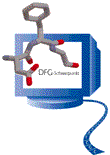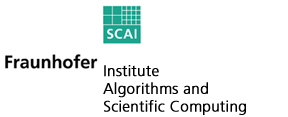
Flexible Description and Optimization of Biological Constraints for the Discovery
of Sequence-Structure Relationships of Proteins
(Flexible Beschreibung und Optimierung biologischer Randbedingungen zur Aufdeckung von
Sequenz-Struktur-Beziehungen von Proteinen)
DFG Project within the DFG Research Program
Informatics Methods for the Analysis and Interpretation of Large Genomic Data Sets
(DFG-Projekt im DFG-Schwerpunktprogramm
Informatikmethoden zur Analyse und Interpretation großer genomischer Datenmengen)

Objective
Development of a system for protein structure prediction that utilizes
biological knowledge formulated in a description language
to optimize the alignment computation
People and Institutes
Fraunhofer Institute
Algorithms and Scientific Computing
Schloss Birlinghoven
D-53754 Sankt Augustin
Mario Albrecht
Dr. Jan Freudenberg
Daniel Hanisch
Prof. Dr. Ralf Zimmer
Prof. Dr. Thomas Lengauer, PhD

Time Scale
Start of project:
October 1, 1999
Duration of first project period:
2 years
Expected total project length:
4 years
Project Description
The project addresses the main problems involved with protein structure prediction,
the design of efficient algorithms and of good scoring functions.
These issues are tackled by the development of a system that allows for the
explicit formulation of biological knowledge in a description language.
This additional knowledge is then used to control efficient optimization procedures
during the alignment and score computation from a high level.
The description language enables users with the help of editors and
automatic tools to specify biological facts and constraints for the
computation in the ProML language, which is based on the XML standard.
Thus data from mass spectrometry and NMR experiments such as cross-link
distances and NOE restraints can also be included into the alignment computation.
The structure prediction algorithm is based on the threading approach
and the recursive dynamic programming method, implemented in the
Java programming language.
To support the knowledge elucidation, we develop new methods to perform
different clusterings of protein sequences and structures in order
to discover additional properties and sequence-structure relationsships.
Publications

Flexible Description and Optimization of Biological Constraints for the Discovery of Sequence-Structure Relationships of Proteins
(Flexible Beschreibung und Optimierung biologischer Randbedingungen zur Aufdeckung von Sequenz-Struktur-Beziehungen von Proteinen)
DFG Project within the DFG Research Program
(DFG-Projekt im DFG-Schwerpunktprogramm Informatikmethoden zur Analyse und Interpretation großer genomischer Datenmengen)

Objective
| Development of a system for protein structure prediction that utilizes biological knowledge formulated in a description language to optimize the alignment computation |
|
Fraunhofer Institute Algorithms and Scientific Computing Schloss Birlinghoven D-53754 Sankt Augustin
Mario Albrecht |
 |
Time Scale
| Start of project: | October 1, 1999 |
| Duration of first project period: | 2 years |
| Expected total project length: | 4 years |
Project Description
|
The project addresses the main problems involved with protein structure prediction, the design of efficient algorithms and of good scoring functions. These issues are tackled by the development of a system that allows for the explicit formulation of biological knowledge in a description language. This additional knowledge is then used to control efficient optimization procedures during the alignment and score computation from a high level. The description language enables users with the help of editors and automatic tools to specify biological facts and constraints for the computation in the ProML language, which is based on the XML standard. Thus data from mass spectrometry and NMR experiments such as cross-link distances and NOE restraints can also be included into the alignment computation. The structure prediction algorithm is based on the threading approach and the recursive dynamic programming method, implemented in the Java programming language. To support the knowledge elucidation, we develop new methods to perform different clusterings of protein sequences and structures in order to discover additional properties and sequence-structure relationsships. |
Publications